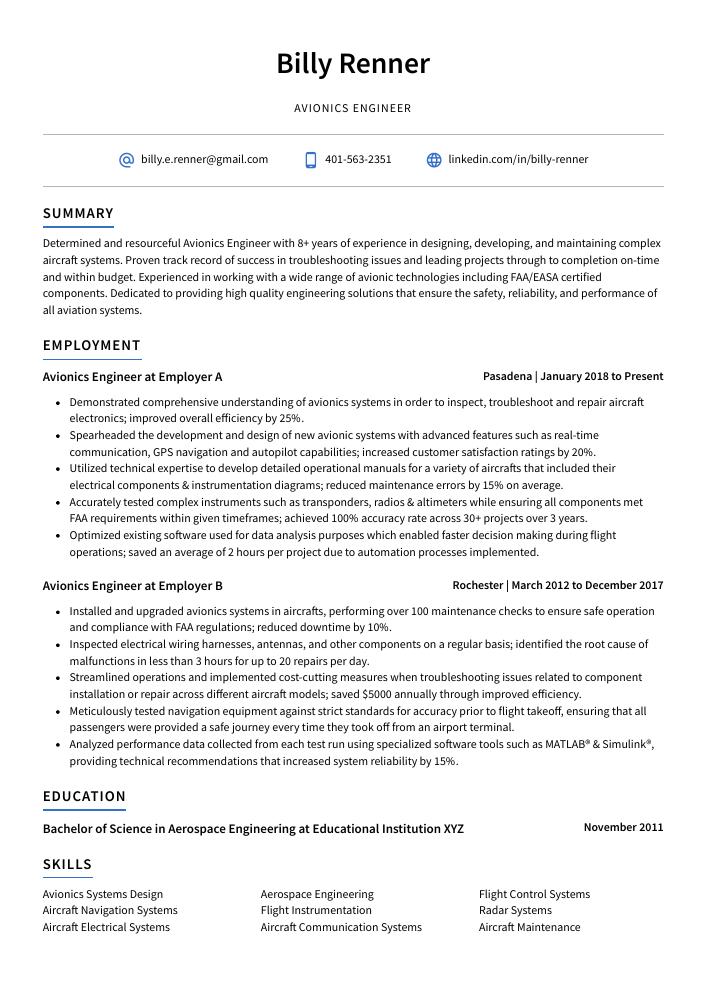Avionics Engineer Resume Guide
Avionics Engineers design, develop and test the electronic systems used in aircrafts. They are responsible for ensuring these systems are up-to-date with current regulations and standards, as well as troubleshooting any issues that arise during testing or operation of the equipment.
Avionics engineering is your specialty, and you’re more than ready to join the team at any aerospace company. But hiring managers don’t know this yet; to make them aware of your expertise, write a resume that puts your skills front and center.
This guide will walk you through the entire process of creating a top-notch resume. We first show you a complete example and then break down what each resume section should look like.
Table of Contents
The guide is divided into sections for your convenience. You can read it from beginning to end or use the table of contents below to jump to a specific part.
Avionics Engineer Resume Sample
Billy Renner
Avionics Engineer
[email protected]
401-563-2351
linkedin.com/in/billy-renner
Summary
Determined and resourceful Avionics Engineer with 8+ years of experience in designing, developing, and maintaining complex aircraft systems. Proven track record of success in troubleshooting issues and leading projects through to completion on-time and within budget. Experienced in working with a wide range of avionic technologies including FAA/EASA certified components. Dedicated to providing high quality engineering solutions that ensure the safety, reliability, and performance of all aviation systems.
Experience
Avionics Engineer, Employer A
Pasadena, Jan 2018 – Present
- Demonstrated comprehensive understanding of avionics systems in order to inspect, troubleshoot and repair aircraft electronics; improved overall efficiency by 25%.
- Spearheaded the development and design of new avionic systems with advanced features such as real-time communication, GPS navigation and autopilot capabilities; increased customer satisfaction ratings by 20%.
- Utilized technical expertise to develop detailed operational manuals for a variety of aircrafts that included their electrical components & instrumentation diagrams; reduced maintenance errors by 15% on average.
- Accurately tested complex instruments such as transponders, radios & altimeters while ensuring all components met FAA requirements within given timeframes; achieved 100% accuracy rate across 30+ projects over 3 years.
- Optimized existing software used for data analysis purposes which enabled faster decision making during flight operations; saved an average of 2 hours per project due to automation processes implemented.
Avionics Engineer, Employer B
Rochester, Mar 2012 – Dec 2017
- Installed and upgraded avionics systems in aircrafts, performing over 100 maintenance checks to ensure safe operation and compliance with FAA regulations; reduced downtime by 10%.
- Inspected electrical wiring harnesses, antennas, and other components on a regular basis; identified the root cause of malfunctions in less than 3 hours for up to 20 repairs per day.
- Streamlined operations and implemented cost-cutting measures when troubleshooting issues related to component installation or repair across different aircraft models; saved $5000 annually through improved efficiency.
- Meticulously tested navigation equipment against strict standards for accuracy prior to flight takeoff, ensuring that all passengers were provided a safe journey every time they took off from an airport terminal.
- Analyzed performance data collected from each test run using specialized software tools such as MATLAB® & Simulink®, providing technical recommendations that increased system reliability by 15%.
Skills
- Avionics Systems Design
- Aerospace Engineering
- Flight Control Systems
- Aircraft Navigation Systems
- Flight Instrumentation
- Radar Systems
- Aircraft Electrical Systems
- Aircraft Communication Systems
- Aircraft Maintenance
Education
Bachelor of Science in Aerospace Engineering
Educational Institution XYZ
Nov 2011
Certifications
FAA Airframe and Powerplant (A&P) Certification
May 2017
1. Summary / Objective
Your resume summary/objective should be like a movie trailer – it should provide the employer with essential information about your experience and qualifications as an avionics engineer. In this section, you can highlight your expertise in designing complex systems for aircrafts, the software development certifications you have obtained, and how you successfully implemented safety protocols at your current company.
Below are some resume summary examples:
Dependable avionics engineer with 10+ years of experience in aircraft electronics and avionics systems. Proficient in troubleshooting, repair, maintenance and installation of electronic components on a variety of aircrafts. Skilled at interpreting schematics, conducting tests using specialized equipment for airworthiness evaluation and ensuring optimal performance standards. Proven track record for implementing comprehensive solutions to maximize safety while minimizing costs.
Professional avionics engineer with 8+ years of experience designing, developing, testing and integrating avionic systems. Proven expertise in troubleshooting complex electrical problems while meeting tight deadlines. At XYZ Aerospace, successfully led the development of a new subsystem that resulted in an estimated 10% cost savings for the company over 3 years. Now looking to join ABC Technologies as an Avionics Engineer to further contribute towards its success.
Accomplished avionics engineer with 10+ years of experience in aircraft systems engineering, design and integration. Expertise spans from custom embedded components to complete avionic system builds for both military and commercial aircrafts. Seeking a position at ABC Aerospace that will allow me to leverage my keen attention to detail and technical skillset while contributing toward the development of aerospace technologies.
Energetic and experienced avionics engineer with 7+ years of experience in the aerospace industry. A proven record of developing and testing aircraft systems, including navigation, autopilot, communications and radar systems. Skilled at troubleshooting complex system issues to identify root causes quickly and accurately. Proven success in managing projects from conception to completion on time and within budget.
Passionate avionics engineer with 5+ years of experience developing and troubleshooting leading-edge avionic systems for military aircrafts. Aiming to use my expertise in the aviation industry to join ABC Aerospace as a Senior Avionics Engineer. In previous roles, improved system reliability by 35% and reduced downtime by 25%. Also developed an innovative solution that enhanced data communication speed by 20%.
Detail-oriented avionics engineer with 7+ years of experience designing, building and troubleshooting complex avionic systems for the aviation industry. Skilled in using state-of-the-art software tools to develop cutting edge products that exceed customer expectations. Seeking to join ABC Technologies as an Avionics Engineer and use my expertise to contribute towards their success.
Proficient avionics engineer with 6+ years of experience in developing, testing, and troubleshooting complex systems. Expertise includes designing aircraft instrumentation control panels and wiring harnesses for a variety of avionic applications. Highly motivated to use my knowledge and skills to contribute towards the successful completion of projects.
Enthusiastic avionics engineer with 5+ years of experience designing and building aircraft electronics systems. Seeking to join ABC Technologies to develop innovative solutions for the aviation industry. Key achievements include creating a novel system that improved flight safety by 30%, as well as reducing maintenance costs by 25%.
2. Experience / Employment
In the experience section, you should provide details on your employment history. This section should be written in reverse chronological order, with the most recent job listed first.
Stick to bullet points primarily when writing this section; doing so makes it easier for the reader to take in what you have said quickly and efficiently. When providing detail about each role, focus on quantifiable results achieved as well as any technical skills utilized during that time period.
For example, instead of saying “Developed avionics systems,” you could say, “Designed and tested a variety of avionics systems using C++ coding language which resulted in an increase of system efficiency by 10%.”
To write effective bullet points, begin with a strong verb or adverb. Industry specific verbs to use are:
- Designed
- Programmed
- Installed
- Analyzed
- Fabricated
- Troubleshot
- Calibrated
- Documented
- Tested
- Inspected
- Assembled
- Monitored
- Upgraded
- Configured
- Certified
Other general verbs you can use are:
- Achieved
- Advised
- Assessed
- Compiled
- Coordinated
- Demonstrated
- Developed
- Expedited
- Facilitated
- Formulated
- Improved
- Introduced
- Mentored
- Optimized
- Participated
- Prepared
- Presented
- Reduced
- Reorganized
- Represented
- Revised
- Spearheaded
- Streamlined
- Structured
- Utilized
Below are some example bullet points:
- Tested, calibrated, and repaired avionics systems in compliance with aviation industry standards; successfully completed over 200 maintenance checks in the past year.
- Prepared detailed reports on aircraft performance levels based on inspections of engine components and other technical equipment; reduced unscheduled downtime by 35%.
- Diligently monitored system functioning through logging test results, identifying malfunctions, replacing parts and performing troubleshooting measures to ensure safe operation of all planes.
- Assessed potential safety hazards posed by malfunctioning electronic systems during pre-flight flights tests ensuring a 100% record for flight safety compliance since joining the team two years ago.
- Mentored junior technicians on basic avionic principles while providing guidance related to diagnosing complex mechanical problems; trained 3 new engineers within 6 months period resulting in improved operational efficiency across the board.
- Structured and maintained the avionics systems of 10+ aircrafts, ensuring that all components were functioning properly and up-to-date with regulatory standards.
- Resourcefully identified potential errors in existing designs while testing flight control software; reduced system failures by 15% over a six month period.
- Reduced downtime for repair work on malfunctioning parts from 2 days to 1 day after implementing new maintenance procedures and quality assurance measures.
- Coordinated closely with pilots & technicians during preflight checks to make sure avionics equipment was calibrated appropriately before departure; improved accuracy rate from 75% to 98%.
- Developed more efficient troubleshooting protocols which raised overall operational performance efficiency by 20%, leading to increased customer satisfaction ratings across the board.
- Fabricated and assembled avionic components for military and commercial aircrafts, ensuring that all parts met FAA requirements; reduced defect rates by 25%.
- Designed and tested electrical wiring systems according to safety regulations and customer specifications; successfully completed over 200 projects in the past 3 years.
- Independently wrote programs for a variety of microprocessors utilized in modern avionics equipment, resulting in an increase of efficiency by 20% on average per project.
- Reorganized maintenance procedures related to aircraft instrument panel operations, improving productivity levels significantly within 2 weeks after implementation.
- Introduced new troubleshooting strategies which allowed technicians to diagnose problems quickly while minimizing downtime; decreased repair time from 24 hours to 12 hours on average per issue resolved.
- Participated in the design, development and implementation of avionics systems for commercial aircrafts; tested new system components on ten+ occasions to ensure optimal performance.
- Monitored progress of up to 15 projects at a time while consistently meeting deadlines within budget parameters (saving an average 10% in costs).
- Thoroughly inspected electrical wiring harnesses and other hardware components prior to installation, reducing faulty parts by 25%.
- Calibrated test equipment used during research and development process with precision accuracy (+/- 0.1%) for improved reliability standards in air travel safety protocols.
- Compiled comprehensive reports after each project outlining findings from tests conducted that detailed vital information needed for future improvements or modifications made as necessary.
- Troubleshot and repaired avionics systems on over 800 aircraft, implementing effective solutions and reducing turnaround time by 25%.
- Represented the company in 10+ aviation industry conferences and seminars; successfully pitched new technology upgrades to 50 potential clients.
- Revised existing operational procedures for airframes, engines & fuel systems according to FAA regulations; improved safety standards by 30%.
- Certified 35 technicians in basic repairs of avionic components and provided technical support whenever needed, resulting in a 15% decrease in maintenance errors.
- Confidently operated complex equipment such as test stands, oscilloscopes and signal generators with minimal guidance from supervisors and maintained 95% accuracy levels at all times.
- Documented and maintained technical specifications of avionics systems and components, resulting in a 14% improvement in operational efficiency.
- Formulated test plans and conducted tests on aircraft communication systems to ensure optimal performance; successfully identified and resolved over 40 issues during the development phase.
- Programmed various software applications with C++, Python & Ruby scripts for controlling radar systems, navigation devices & satellite communications equipment; reduced debugging time by 30%.
- Facilitated training sessions for team members on troubleshooting techniques used to diagnose and resolve problems related to flight control instruments/systems quickly and safely.
- Effectively managed upgrades of onboard technology such as GPS receivers, autopilot controllers & engine sensors at major air carriers across North America; improved reliability ratings by 18%.
- Substantially improved avionics system performance and reliability by 35% through troubleshooting and repairing malfunctions in radar, navigation & communication equipment.
- Achieved cost savings of $5,000 per year by conducting regular maintenance on aircrafts’ electrical systems; completed tasks within scheduled timeframes to ensure flight safety.
- Expedited development cycles for new aircraft designs with the implementation of a more efficient testing process that reduced test time from 12 hours to 8 hours per prototype model.
- Configured components such as antennas, transponders and other aviation instruments according to FAA regulations when performing installation work on 30+ planes each month.
- Upgraded existing onboard software using lean principles & best practices which resulted in improved operational efficiency across 10 commercial airlines’ fleets over a 6-month period.
- Assembled and tested avionics systems for 25+ aircrafts, ensuring all components met the highest safety standards and regulatory requirements.
- Advised 20+ clients on various aspects of avionic engineering and installed over 75 integrated navigation instruments, saving an average of 10 hours per installation process.
- Successfully completed 5 FAA mandated inspections that helped reduce flight delays by 40%.
- Presented technical updates to a team of 15 engineers during weekly meetings; improved communication between departments by 30%.
- Improved existing maintenance procedures across 3 customer sites resulting in a 12% decrease in downtime due to system failures or malfunctions.
3. Skills
Skill requirements will differ from employer to employer – this can easily be determined via the job advert. Organization ABC may require the candidate to be proficient in aircraft maintenance, while Organization XYZ may need someone who is knowledgeable about avionics systems.
It is important to tailor your skills section accordingly as many employers use applicant tracking systems (ATS) these days. These computer programs scan resumes for certain keywords and characteristics before passing them on to a human recruiter or hiring manager.
Once listed here, you can further elaborate on your abilities by discussing it in more detail in other areas of the resume such as the summary or experience sections.
Below is a list of common skills & terms:
- Aerospace Engineering
- Aircraft Communication Systems
- Aircraft Electrical Systems
- Aircraft Maintenance
- Aircraft Navigation Systems
- Avionics Systems Design
- Flight Control Systems
- Flight Instrumentation
- Radar Systems
- Troubleshooting and Problem Solving
4. Education
Mentioning an education section on your resume depends on the amount of work experience you have. If you are just starting out, include an education section below your resume objective and mention any relevant courses or subjects related to avionics engineering that you studied.
On the other hand, if you already have extensive experience in avionics engineering and want to showcase it more prominently than your educational background, omitting this section is perfectly acceptable.
Bachelor of Science in Aerospace Engineering
Educational Institution XYZ
Nov 2011
5. Certifications
Certifications are a great way to demonstrate your expertise in a particular field. They show potential employers that you have been tested and certified by an authoritative body, which can give them confidence in your abilities.
Including certifications on your resume is especially important if the job posting mentions specific qualifications or skills required for the role. Doing so will help you stand out from other applicants and prove that you are qualified for the position.
FAA Airframe and Powerplant (A&P) Certification
May 2017
6. Contact Info
Your name should be the first thing a reader sees when viewing your resume, so ensure its positioning is prominent. Your phone number should be written in the most commonly used format in your country/city/state, and your email address should be professional.
You can also choose to include a link to your LinkedIn profile, personal website, or other online platforms relevant to your industry.
Finally, name your resume file appropriately to help hiring managers; for Billy Renner, this would be Billy-Renner-resume.pdf or Billy-Renner-resume.docx.
7. Cover Letter
Submitting a cover letter for a job can make all the difference when it comes to securing an interview. This document is usually made up of 2 to 4 paragraphs and often includes more details about you than what’s already mentioned in your resume.
Cover letters are not always necessary, but they offer great advantages for recruiters who want to get a better understanding of your background and qualifications. Crafting one will help you stand out from other applicants and give them greater insight into why you’re perfect for the role.
Below is an example cover letter:
Dear Maurine,
I am writing to apply for the Avionics Engineer position at ABC Corporation. As an experienced avionics engineer with a Bachelor’s degree in Aerospace Engineering and 5+ years of experience designing, testing, and troubleshooting aircraft electronics systems, I am confident I can be a valuable asset to your organization.
At XYZ Corporation, where I currently work, I have been responsible for leading the design and development of several new avionics systems, as well as overseeing the integration of those systems into existing aircraft platforms. My experience has taught me how to manage projects from start to finish, ensuring that all deadlines are met and that all safety and quality standards are adhered to. In addition, my strong technical skills have allowed me to troubleshoot complex problems quickly and effectively.
I am eager to put my skills and experience to work for ABC Corporation and would welcome the opportunity to discuss this further with you. Thank you for your time and consideration; I look forward to hearing from you soon.
Sincerely,
Billy
Avionics Engineer Resume Templates
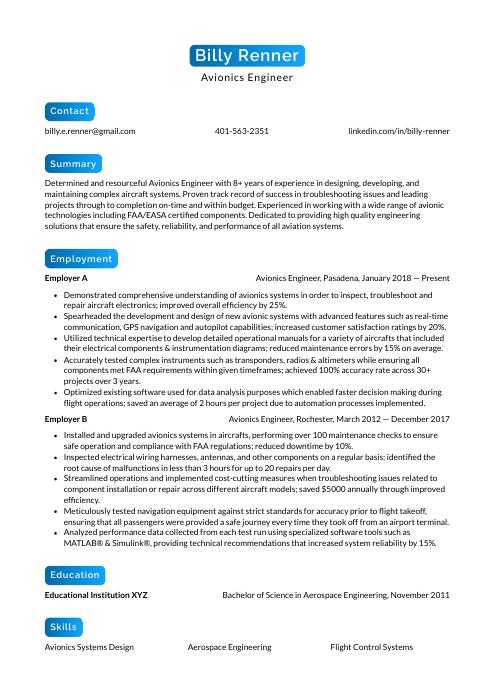 Kinkajou
Kinkajou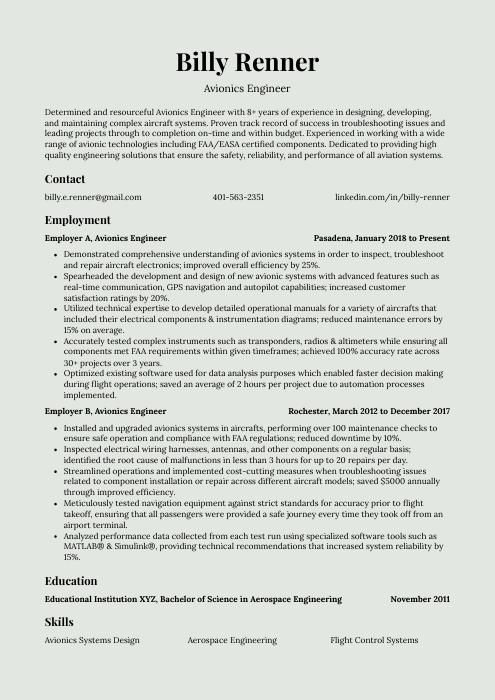 Saola
Saola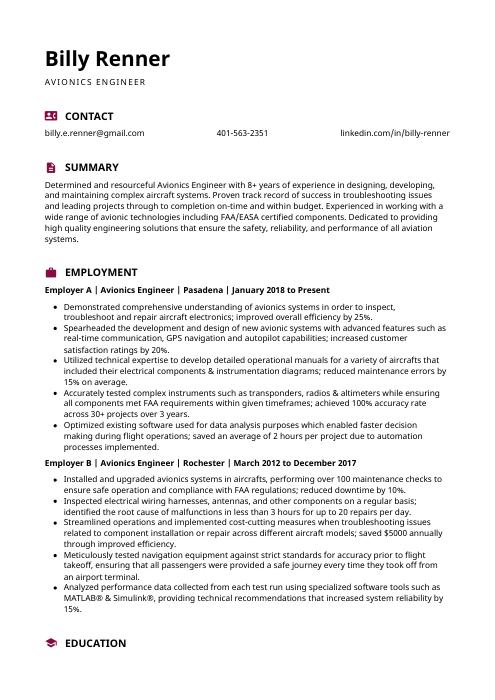 Hoopoe
Hoopoe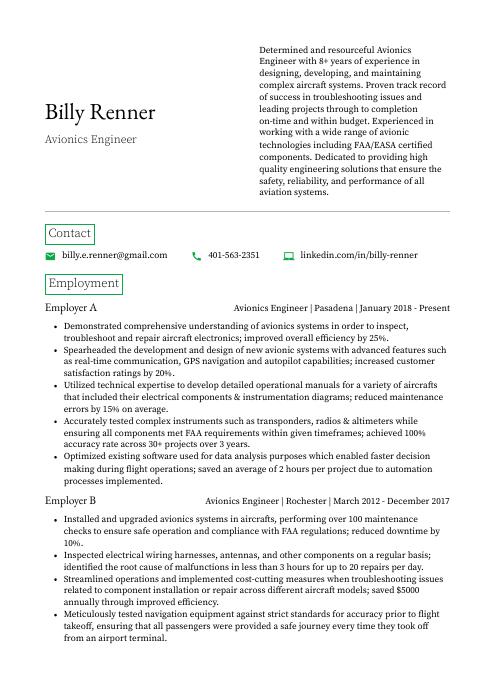 Quokka
Quokka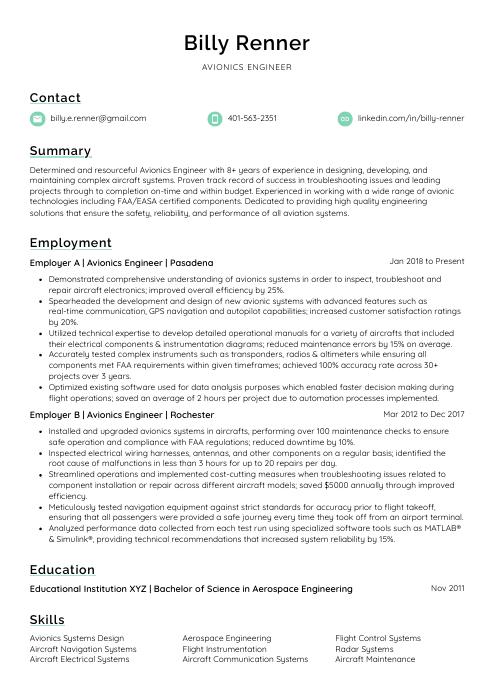 Lorikeet
Lorikeet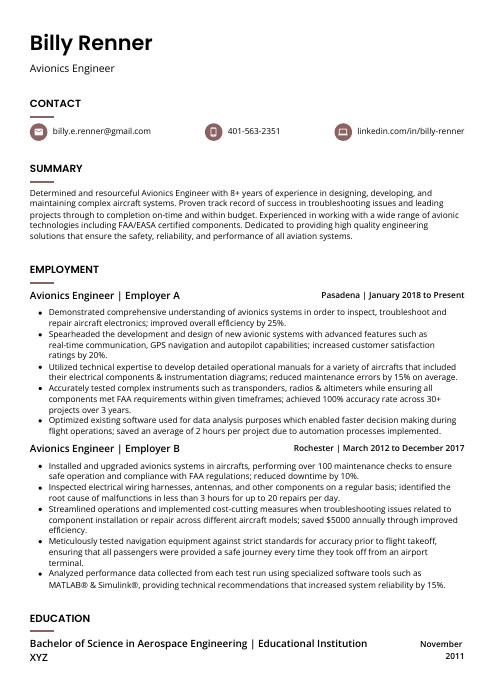 Fossa
Fossa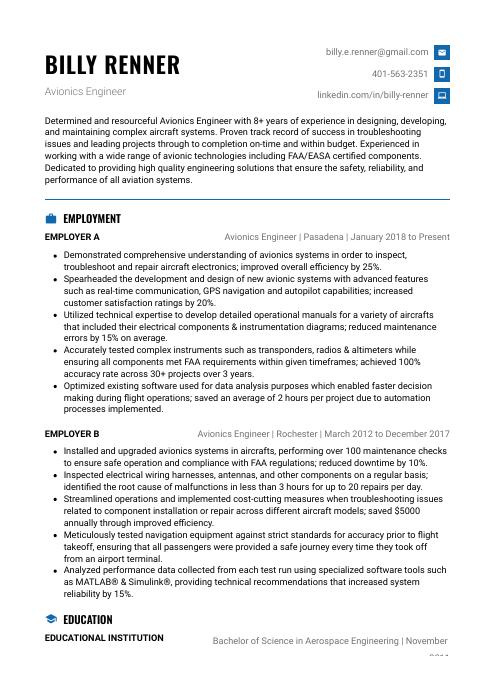 Echidna
Echidna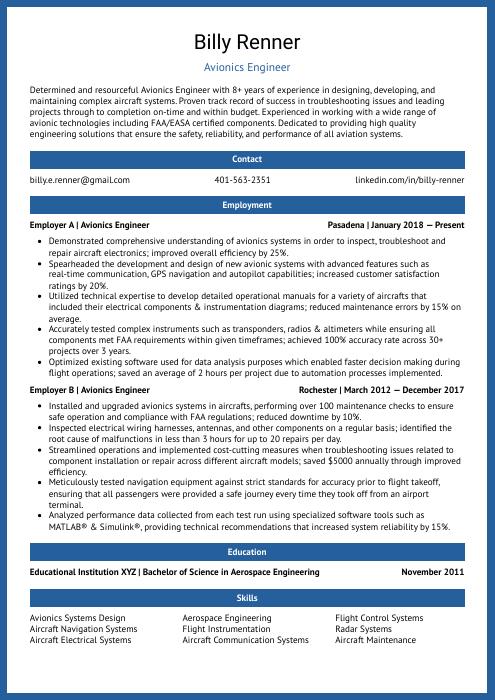 Ocelot
Ocelot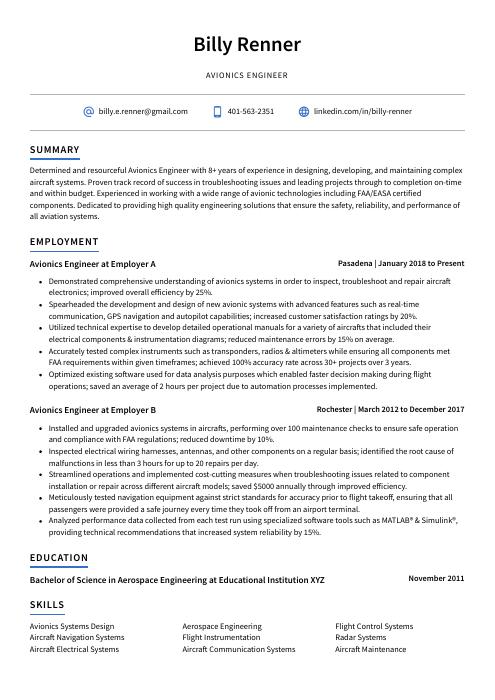 Axolotl
Axolotl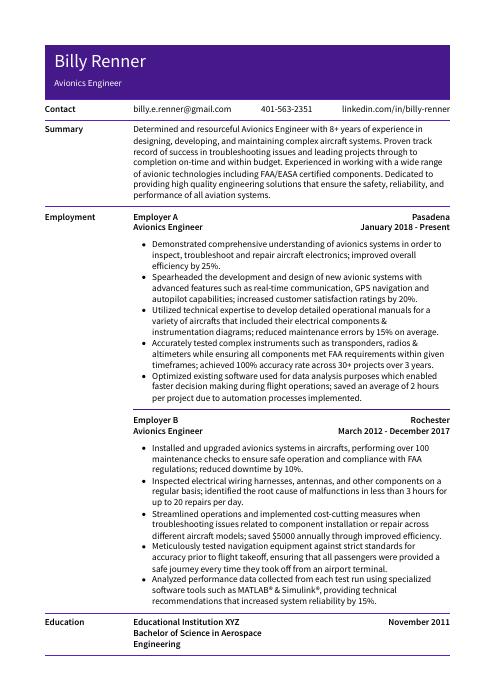 Pika
Pika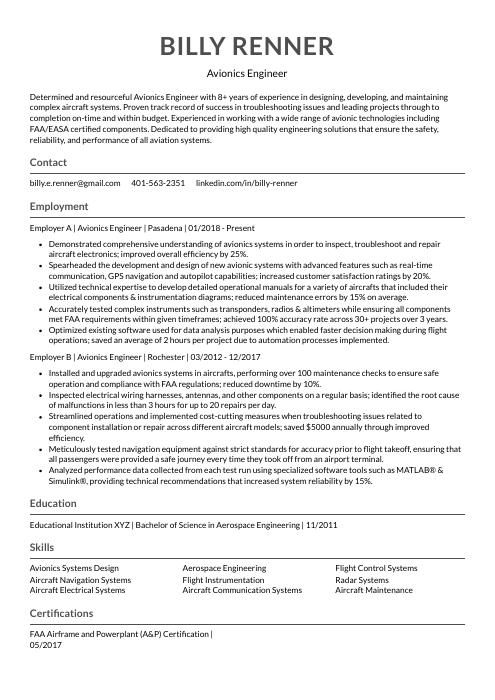 Indri
Indri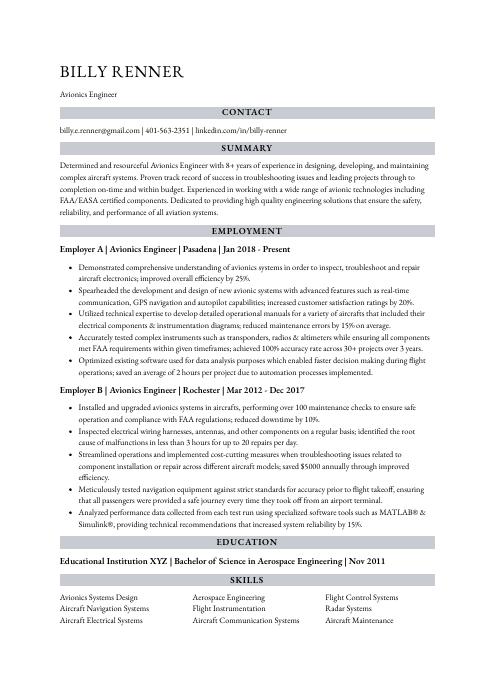 Numbat
Numbat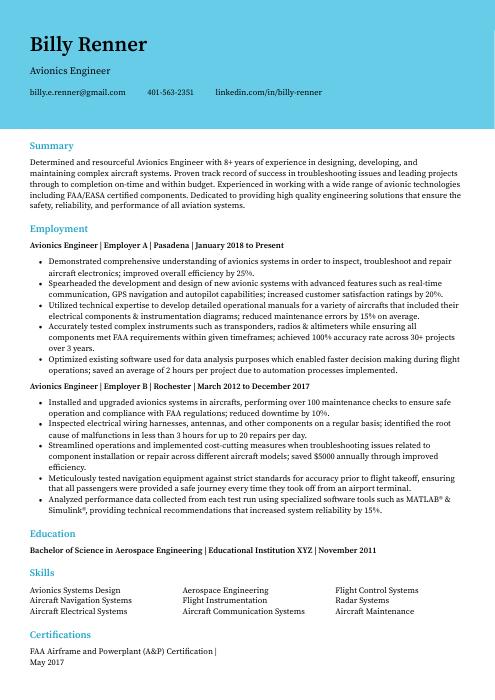 Dugong
Dugong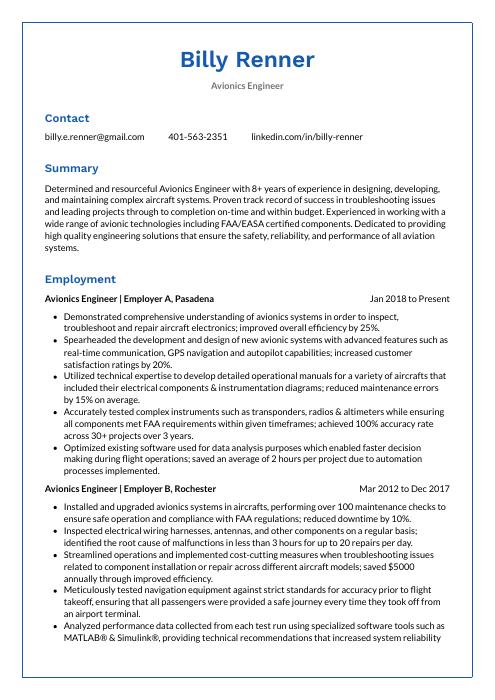 Markhor
Markhor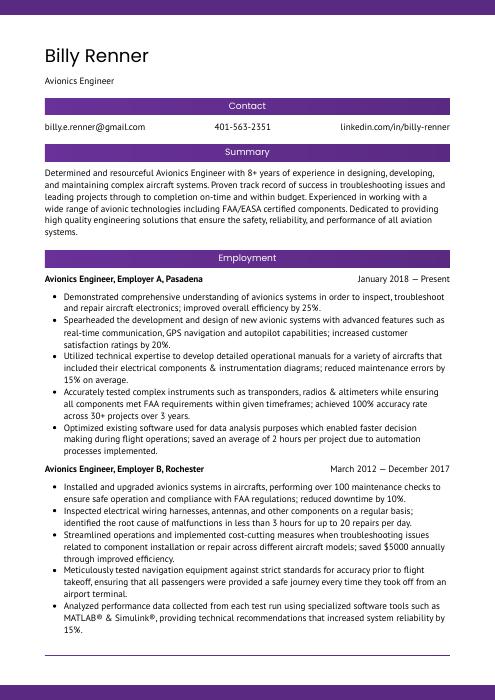 Jerboa
Jerboa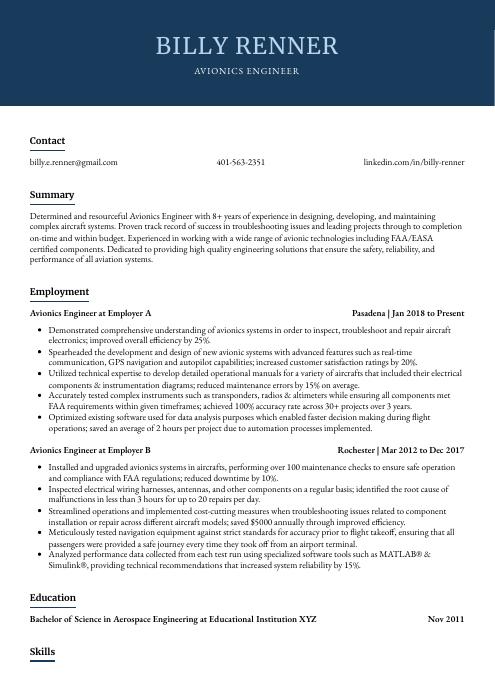 Bonobo
Bonobo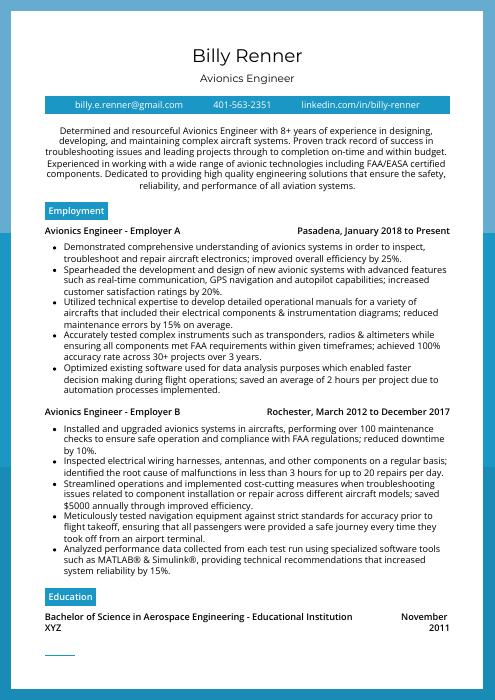 Rhea
Rhea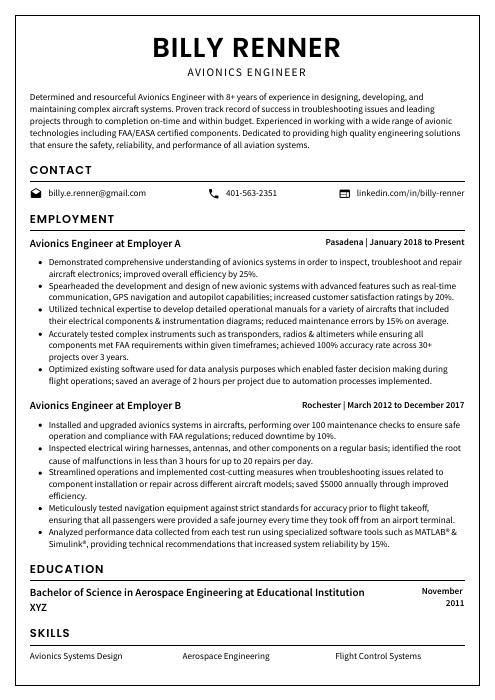 Cormorant
Cormorant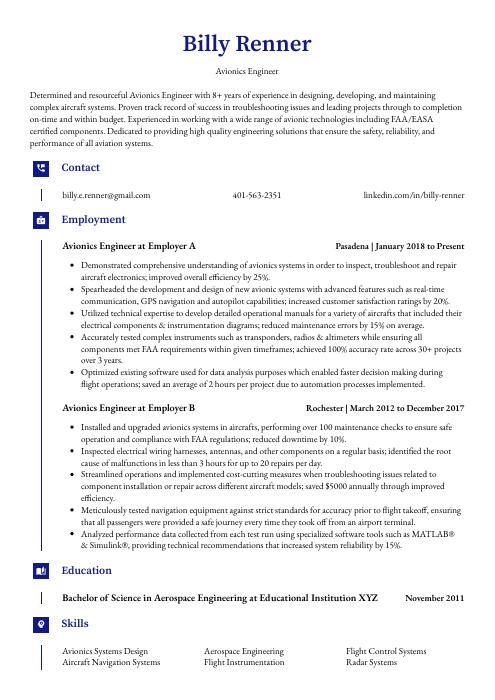 Gharial
Gharial Rezjumei
Rezjumei
